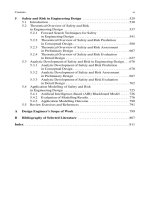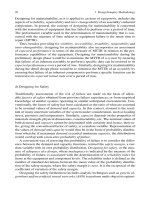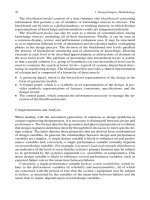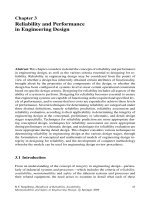Handbook of Reliability, Availability, Maintainability and Safety in Engineering Design - Part 6 doc
Bạn đang xem bản rút gọn của tài liệu. Xem và tải ngay bản đầy đủ của tài liệu tại đây (55.13 KB, 10 trang )
30 1 Design Integrity Methodology
The blackboard model consists of a data structure (the blackboard) containing
information that permits a set of modules or knowledge sources to interact. The
blackboard can be seen as a global database, or working memory in which distinct
representations of knowledge and intermediate results are integrated uniformly.
The blackboard model can also be seen as a means of communication among
knowledge sources, mediating all of their interactions. Finally, it can be seen as
a common display, review, and performance evaluation area. It may be structured
so as to represent different levels of abstraction and also distinct and/or overlapping
phases in the design process. The division of the blackboard into levels parallels
the process of hierarchical structuring and of abstraction of knowledge, allowing
elements at each level to be described approximately as abstractions of elements at
the next lower level. The partition of knowledge into hierarchical levels is useful,
in that a partial solution (i.e. group of hypotheses) at one hierarchical level can be
used to constrain the search at lower levels—typical of systems h ierarchical struc-
turing in engineering design. The blackboard thus provides a shared representation
of a design and is composed of a hierarchy of three panels:
• A geometry panel, which is the lowest-level representation of the design in the
form of geometric models.
• A feature panel, which is a symbolic-level representation of the design. It pro-
vides symbolic representations of features, constraints, specifications, and the
design record.
• The control panel, which contains the information necessary to manage the op-
eration of the blackboard model.
f) Implementation and Analysis
When dealing with the automated generation of solutions to design problems in
a target engineering design project, it is necessary to distinguish between design and
performance. The former denotes the geometric and physical propertiesofa solution
that design engineers determine directly through their decisions to meet specific de-
sign criteria. The latter denotes those properties that are derived from combinations
of design variables. In general, the relationships between design and performance
variables are complex. A single design variable is likely to influence several perfor-
mance variables and, conversely, a single performance variable normally depends
on several design variables. For example, a system’s load and strength distributions
are indicative of the level of stress that the system’s primary function may be subject
to, as performed by the system’s equipment (i.e. assemblies or components). This
stress design variable is likely to influence several performance variables, such as
expected failure rate or the mean time between failures.
Conversely, a single p erformance variable such as system availability,whichre-
lates to the performance variables of reliability and maintainability, a ll of which
are concerned with the period of time that the system’s equipment may be subject
to failure, as measured by the variables of the mean time between failures and the
mean time to repair, depends upon several design variables.
1.2 Artificial Intelligence in Design 31
These design variables are concerned with equipment usage or application over
aperiodoftime,theaccessibility and repairability of the system’s related equip-
ment in the event of failure, and the system’s load and strength distributions. As
a consequence, neither design nor performance variables should be considered in
isolation. Whenever a design is evaluated, it should be reasonably complete (relative
to the particular level of abstraction—i.e. design stage—at which it is conceived),
and it should be evaluated over the entire spectrum of performance variables that
are relevant for that level. Thus, for conventional engineering designs, the tendency
is to separate the generation of a design from its subsequent evaluation (as opposed
to optimisation, where the two processes are linked), whereas the use of an AIB
blackboard model looks at preliminary design analysis and process definition con-
currently with design constraints and process performance assessment.
On this basis, particularly with respect to the design constraints and performance
assessment, the results of trial tests of the implementation of the AIB blackboard
model in a target engineering design p roject are analysed to determine the appli-
cability of automated continual design reviews throughout the engineering design
process. This is achieved by defining a set of performance measures for each sys-
tem, such as temperature range, pressure rating, output, and flow rate, according to
the required design specifications identified in the process definition.
It is not particularly meaningful, however, to use an actual performance measure;
rather, it is the proximity of the actual performance to the limits of capability (design
constraints) of the system (i.e. the safety margin) that is more useful. In preliminary
design reviews, the proximity of performance to a limit closely relates to a mea-
sure of its safety margin. This is determined by formulating a set of performance
constraints for which a design solution is found that maximises the safety margins
with respect to these performance constraints, so that a maximum safety margin is
achieved with respect to all p erformance criteria.
Chapter 2
Design Integrity and Automation
Abstract The overall combination of the topics of reliability and perform ance, avail-
ability and maintainability, and safety and risk in engineering design constitutes
a methodology that provides the means by which complex engineering designs can
be properly analysed and reviewed. Such an analysis and review is conducted not
only with a focus on individual inherent systems but also with a perspective of the
critical combination and complex integration of all of the design’s systems and re-
lated equipm ent, in order to achieve the required design integrity. A basic and funda-
mental understanding of the concepts of reliability, availability and maintainability
and, to a large extent, an empirical understanding of safety have in the main dealt
with statistical techniques for the measure and/or estimation of various parameters
related to each of these concepts that are based on obtained data.However,inde-
signing for reliability, availability, maintainability and safety, it is more often the
case that the measures and/or estimations of various parameters related to each of
these concepts are not based on obtained data. Furthermore, the complexity arising
from an integration of engineering systems and their interactionsmakes it somewhat
impossible to gather meaningful statistical data that could allow for the use of ob-
jective probabilities in the analysis of the integrity of engineering design. Other ac-
ceptable methods must therefore be sought to determine the integrity of engineering
design in the situation where data are not available or not meaningful. Methodology
in which the technical uncertainty of inadequately defined design problems may be
formulated in order to achieve maximum design integrity has thus been developed
to accommodate its use in conceptual and preliminary engineering design in which
most of the design’s systems and components have not yet been precisely defined.
This chapter gives an overview of design automation methodology in which the
technical uncertainty of inadequately defined design problems may be formulated
through the application o f intelligent design systems that can be used in creating or
altering conceptual and preliminary engineering designs in which most of the de-
sign’s systems and components still need to be defined, as well as evaluate a design
through the use of evaluation design automation (EDA) tools.
R.F. Stapelberg, Handbook of Reliability, Availability, 33
Maintainability and Safety in Engineering Design,
c
Springer 2009
34 2 Design Integrity and Automation
2.1 Industry Perception and Related Research
It is obvious that most of the problems of recently constructed super-projects stem
from the lack of a proper evaluation of the integrity of their design. Furthermore, it
is obvious that a severe lack of insight exists in the essential activities required to
establish a proper evaluation of the integrity of engineering design—with the con-
sequence that many engineering design projects are subject to relatively superficial
design reviews, especially with large, complex and expensive process plants.
Based on the results of cost ‘blow-outs’ of these super-projects, the conclusion
reached is that insufficient research has been conducted in the determination of the
integrity of engin eering design, its application in design procedure, as well as in the
severe shortcomings of current design review techniques.
2.1.1 Industry Perception
It remains a fact that, in most engineering design organisations, the designs of large
engineering projects are based upon the theoretical expertise and practical experi-
ences pertaining to chemical, civil, electrical, industrial, mechanical and process en-
gineering, from the point of view of ‘what should be achieved ’ to meet the demands
of various design criteria. It is apparent, though, that not enough consideration is
being given to the point of view of ‘what should be assured ’ in the event that the
demands of design criteria are not met.
As previously indicated, the tools that most design engineers resort to in deter-
mining integrity of design are techniques such as hazardous operations (HazOp)
and simulation, whereas less frequently used techniques include hazards analysis
(HazAn), fault-tree analysis (FTA), failure modes and effects analysis (FMEA) and
failure modes effects and criticality analysis (FMECA).
It unfortunately also remains a fact that most of these techniques are either mis-
understood or conducted incorrectly, or not even conducted at all, with the result
that many high-cost engineering ‘super-projects’ eventually reach the construction
phase without having been subjected to a rigorous evaluation of the integrity of their
designs. One of the outcomes of the research presented in this h andbook has been
the development of an artificia l intelligence-based (AIB) model in which AI mod-
elling techniques, such as the inclusion of knowledge-based expert systems within
a blackboard model, have been applied in the development of intelligent computer
automated methodology for determining the integrity of engineering design. The
model fundamentally provides a capability for automated continual design reviews
throughoutthe engineering design process, whereby groups of design engineers col-
laborativelyinput specific design data and schematics into their relevant knowledge-
based expert systems, which are then concurrently evaluated for integrity of the de-
sign. The overall perception in industry of the benefits of such a methodology is
still in its infant stages, particularly the concept of having a diverse team of experts
or multidisciplinary groups of design engineers available at all stages of a design,
2.1 Industry Perception and Related Research 35
as represented b y their knowledge-based expert systems. The potential savings in
avoiding cost ‘blow-outs’ during engineering project construction are still not prop-
erly appreciated,and the practicalimplementation of a collaborative AIB blackboard
model from conceptual design through to construction still needs further evaluation.
2.1.2 Related Research
As indicated previously,many of the methods and techniques applied in the fields o f
reliability, availability, maintainability and safety have been thoroughly explored by
many other researchers. Some of the more significant findings of these researchers
are grouped into the various topics of ‘reliability and performance’, ‘availability and
maintainability’, and ‘safety and risk’ that are included in the theoretical overview
and analytic development chapters in this handbook. Further research in the applica-
tion of artificial intelligence in engineering design can be found in the comprehen-
sive three-volume set of multidisciplinary research papers on ‘Design representation
and models of routine design’; ‘Models of innovative design, reasoning about phys-
ical systems, and reasoning about geometry’; and ‘Knowledgeacquisition, commer-
cial systems, and integrated environments’ (Tong and Sriram 1992).
Research in the application of artificial in telligence in engineering design has
also been conducted b y authorities such as the US Department of Defence (DoD),
the US National Aeronauticsand Space Administration(NASA) and the US Nuclear
Regulatory Commission (NUREG).
Under the topics of reliability and performance, some of the more recent re-
searchers whose works are closely related to the integrity of engineering design,
particularly designing for reliability, covered in this h andbook are S.M. Batill,
J.E. Renaud and Xiaoyu Gu in their simulation modelling of uncertainty in mul-
tidisciplinary design optimisation (Batill et al. 2000); B.S. Dhillon in his funda-
mental research into reliability engineering in systems design and design reliability
(Dhillon 1999a); G. Thompson, J.S. Liu et al. in their practical methodology to de-
signing for reliability (Thompson et al. 1999); W. Kerscher, J. Booker et al. in their
use o f fuzzy control methods in information integrationtechnology(IIT) for process
design (Kerscher et al. 1998); J.S. Liu and G. Thompson again, in their approach to
multi-factor design evaluation through parameter profile analysis (Liu and Thomp-
son 1996); D.D. Boettner and A.C. Ward in their use of artificial intelligence (AI) in
engineering design and the application of labelled interval calculus in multi-factor
design evaluation (Boettner and Ward 1992); and N.R. Ortiz, T.A. Wheeler et al.
in their use of expert judgment in nuclear engineering p rocess design (Ortiz et al.
1991). Note that all these data sources are included in the References list of Chap-
ter 3.
Under the topics of availability and maintainability, some of the researchers
whose works are related to the integrity of engineering design, particularly design-
ing for availability and designing for maintainability, covered in this handbook are
V. Tang and V. Salminen in their unique theory of complicatedness as a framework
36 2 Design Integrity and Automation
for complex systems analysis and engineering design (Tang and Salminen 2001);
X. Du and W. Chen in their extensive modelling of robustness in engineering de-
sign (Du and Chen 1999a); X. Du and W. Chen also consider a methodology for
managing the effect of uncertainty in simulation-based design and simulation-based
collaborative systems design (Du and Chen 1999b,c); N.P. Suh in his research into
the theory of complexity and periodicity in design (Suh 1999); G. Thompson, J. Ge-
ominne and J.R. Williams in their method of plant design evaluation featuring main-
tainability and reliability (Thompson et al. 1998); A. Parkinson, C. Sorensen and
N. Pourhassan in their approach to determining robust optimal engineering design
(Parkinson et al. 1993); and J.L. Peterson in his research into Petri net (PN) theory
and its specific application in the design of engineering systems (Peterson 1981).
Note that all these data sources are included in the References list of Chapter 4.
Similarly, under the topics of safety and risk, some of the researchers whose
works are also related to the integrity of engineering design and covered in this
handbook are A. Blandford, B. Butterworth et al. in their modelling applications
incorporating human safety factors into the design of complex engineering systems
(Blandford et al. 1999); R.L. Pattison and J.D. Andrews in their use of genetic al-
gorithms in safety systems design (Pattison and Andrews 1999); D. Cvetkovic and
I.C. Parmee in their multi-objective optimisation of preliminary an d evolutionary
design (Cvetkovic and Parmee 1998); M. Tang in his knowledge-based architecture
for intelligent design support (Tang 1997); J.D. Andrews in his determination of
optimal safety system design using fault-tree analysis (Andrews 1994); D.W. Coit
and A.E. Smith for their research into the use of genetic algorithms for optimising
combinatorialdesign problems (Coit and Smith 1994); H. Zarefar and J.R. Goulding
in their research into neural networks for intelligent design (Zarefar and Goulding
1992); S. Ben Brahim and A. Smith in their estimation of engineering design perfor-
mance using neural networks (Ben Brahim and Smith 1992), as well as G. Chrys-
solouris and M. Lee in their u se of neural networks for systems design (Chrys-
solouris and Lee 1989), and J.W. McManus of NASA Langley Research Center in
his pioneering work on the analysis of concurrent blackboard systems (McManus
1991). Note that all these data sources are included in the References list of Chap-
ter 5.
Recently published material incorporatingintegrity in engineeringdesign are few
and either focus on a single topic, predominantly reliability, safety and risk, or are
intended for specific engineering disciplines, especially electrical and/or electronic
engineering. Some of the more recent publications on the application of reliabil-
ity, maintainability, safety and risk in industry, rather than in e ngineering design
include N.W. Sachs’ ‘Practical plant failure analysis: a guide to understanding ma-
chinery deterioration and improving equipment reliability’ (Sachs 2006), which
explains how and why machinery fails and how basic failure mechanisms occur;
D.J. Smith’s ‘Reliability, maintainability and risk: practical methods for engineers’
(Smith 2005), which considers the integrity of safety-related systems as well as
the latest approaches to reliability modelling; and P.D.T. O’Connor’s ‘Practical re-
liability engineering’ (O’Connor 2002), which gives a comprehensive, up-to-date
description of all the important methods for the design, development, manufacture
2.2 Intelligent Design Systems 37
and maintenance of engineering products and systems. Recent publications relating
specifically to design integrity include E. Nikolaidis’ ‘Engineering design reliabil-
ity handbook’ (Nikolaidis et al. 2005), which considers reliability-based design and
modelling of uncertainty when data are limited.
2.2 Intelligent Design Systems
Methodology in which the technical uncertainty of inadequately defined design
problems may be formulated in order to achieve maximum design integrity has been
developed in this research to accommodate its use in conceptual and preliminary en-
gineeringdesign in which most of the design’s systems andcomponents have not yet
been precisely defined. Furthermore, intelligent computer automated methodology
has been developed through artificial intelligence-based (AIB) modelling to provide
a m eans for continual design reviews throughout the engineering design process.
This is progressively becoming acknowledged as a necessity, not only for use in
future large process super-projects but for engineering design projects in general,
particularly construction projects that incorporate various engineering disciplines
dealing with, e.g. high-rise buildings and complex infrastructure projects.
2.2.1 The Future of Intelligent Design Systems
Starting from current methods in the engineering design process, and projecting our
vision further to new methodologies such as AIB modelling to provide a means for
continual design reviews throughout the engineering design process, it becomes ap-
parent that there can and should be a rapid evolution of the application of intelligent
computer automated methodology to future engineering designs. Currently, three
generations of design tools and approaches can be enumerated: The first generation
is what we currently have—a variety of tools for representing designs and design
information, in many cases not integrated nor well catalogued, with the following
features:
• Information flows consume much time of personnel involved.
• Engineers spend much of their time on managerial, rather than technical tasks.
• Constraints from downstream are rarely considered.
Widespreaduse of knowledge-basedsystems will rapidly be adopted,markinga sec-
ond generation in which techniques become available that allow first-generation
tools to be integrated, networked and coordinated.
Most companies are already fully networked and integrated. The following pro-
jections can be made for this second generation of knowledge-based systems and
tools:
38 2 Design Integrity and Automation
• Knowledge-basedtools are developedto complementandreplace first-generation
shells. These are targeted for design assistance, rather than for general design ap-
plications, especially tools for design evaluation, selection and review problems
that can be enhanced and expanded for a wide range of different engineering
applications.
• Various design strategies are built into expert system shells, so that knowledge
from new areas of engineering design can be utilised appropriately.
Projecting even further, the third generation will arise as there is widespread au-
tomation of the application of knowledge-based tools such as design automation,
which will r equire advances in the application of machine learning and knowledge
acquisition techniques, and the au tomation of new innovations in design verification
and validation such as evaluation design automation.
The third generation will also have automated the process of applying these tools
in design organisations. With each generation, the key aspects of the previous gen-
erations become ever more widespread as technology moves out of the research and
development phase and into commercial products and tools.
The above projections and trends are expected in the following areas:
• Degree of integration and networking of intelligent design tools;
• Degree of automation of the application of design tool technology;
• Sophistication of general-purpose tools (shells);
• Degree of usage in engineering design organisations;
• Degree of understanding of the design process of complex systems.
2.2.2 Design Automation and Evaluation Design Automation
Research work on design automation (DA) has concentrated on programs that play
an active role in the design process, in that they actually create or alter the design.
A design automation environment typically contains a design representation or de-
sign database through which the design is controlled. Such a design automation
environment usually interacts with a predetermined set of resident computer-aided
design (CAD) tools, and will attempt to act as a manager of the CAD tools by han-
dling input/output requirements and possibly automatically sequencing these CAD
tools. Furthermore, it provides a design platform acting as a framework that, in ef-
fect, shields the designer from cumbersome details and allows for design work at
a high level of abstraction during the earlier phases of the engineering design pro-
cess (Schwarz et al. 2001).
Evaluation design automation (EDA) tools, on the other hand, are passive in
that they evaluate a design in order to determine how well it performs. Evaluation
design automation uses a ‘frame-based’ knowledge representation to store and pro-
cess expert knowledge. Frames providea means of grouping packages of knowledge
that are related to each other in some manner, where each knowledge package may
have widely differing representations. The packages of knowledge are referred to
2.2 Intelligent Design Systems 39
as ‘slots’ in the frame. The various slots could contain knowledge such as symbolic
data indicating performance values, heuristic rules indicating likely failure modes,
or procedures for design review routines. The knowledge contained in these slots
can be grouped according to a systems hierarchy, and the frames as such can be
grouped to form a hierarchy of contexts.
Another important aspect to EDA is constraint propagation, for it is through
constraint propagation that design criteria a re aligned with implementation con-
straints. Usually, constraint propagation is achievable through data-directed invo-
cation. Data-directed invocation is the mechanism that allows the design to incre-
mentally progress as the objectives and needs of the design become apparent. In this
fashion, the design constraints will change and propagate with each modification to
the partial design. This is important, since the design requirements typically cannot
be determined a priori (Lee et al. 1993).
The construct of Chapters 3, 4 and 5 in Part II is based upon the prediction,
assessment and evaluation of reliability, availability, maintainability and safety, ac-
cording to the particular engineering d esign phases of conceptual design, prelimi-
nary design and detail design respectively. Besides an initial introduction into en-
gineering design integrity, the chapters are further subdivided into the related top-
ics of theory, analysis and practical application of each of these concepts. Thus,
Chapters 3, 4 and 5 include a theoretical overview, which gives a certain breadth
of research into the theory covering each concept in engineering design; an insight
into analytic development, which gives a certain depth of research into up-to-date
analytical techniques and methods that have been developed and are currently being
developed for analysis of each concept in engineering design; and an exposition of
application modelling, whereby specific computationalmodelshavebeen developed
and applied to the different concepts, particularly AIB modelling in which expert
systems within a networked blackboard model are applied to determine engineering
design integrity.
Part II
Engineering Design Integrity Application









